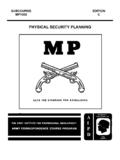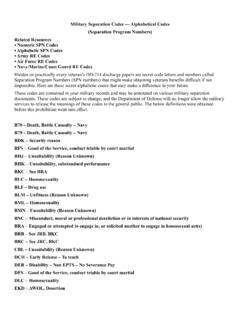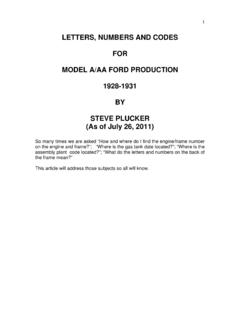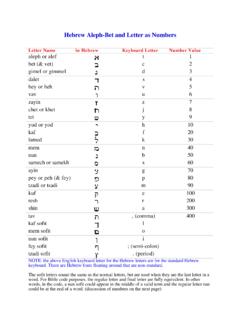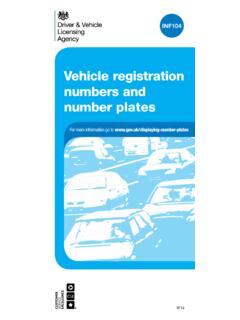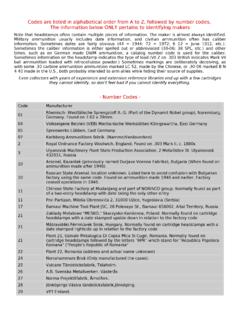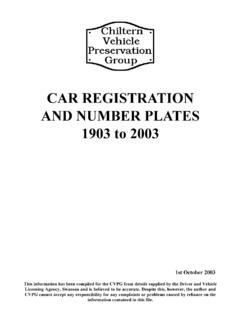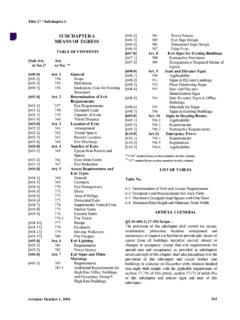Transcription of INTERPRETING AMMUNITION MARKINGS AND COLOR …
1 INTERPRETING AMMUNITION MARKINGSAND COLOR CODESSUBCOURSE MM2597 Edition 6 United States Army Combined Arms Support CommandFort Lee, Virginia 23801-18092 Credit HoursCONTENTSINTRODUCTIONAMMUNITION MARKINGS AND COLOR CODES (Tasks 093-400-1100 through 093-400-1109), 1 INTERPRETING AMMUNITION MARKINGS , 1 Stock Numbers, 1. Department of Defense Identification code , 2. Department of Defense AMMUNITION code , 2. Nomenclature, 2. Supplementary Information, 2. Abbreviations, 3. US Army Model Numbers, 3. Model Numbers of Other US Services, 3. Additional Data, 3. Lot number , 5. MARKINGS on AMMUNITION Items, AMMUNITION COLOR Codes, 6 COLOR by Primary Use, 7. Bands, 8. Combining COLOR Codes, 8. Standard COLOR Codes, 9. Exceptions, 9. Special COLOR Codes, 9. Special Symbols, EXERCISES, 14 EXERCISE SOLUTIONS, 22 INTRODUCTIONIt is essential that an AMMUNITION specialist be able to identify AMMUNITION . Before you can do this, however, you must learn how to interpret AMMUNITION MARKINGS and COLOR may not be aware of it, but you have already been exposed to the use of marking and COLOR code systems to identify items.
2 There are the MARKINGS on products in stores, for example. The label on a container tells you what is in a container, the amount, and who made, it. Traffic lights, fire engines, and police cars are examples of COLOR coding. AMMUNITION MARKINGS and COLOR coding work in much the same way. You will know a great deal about an AMMUNITION item if you understand the marking and COLOR code This subcourse, INTERPRETING AMMUNITION MARKINGS and COLOR Codes, consists of one lesson based on the following tasks from soldier's manual STP 9-55B12-SM: 093-400-1100, Identify , Identify Artillery , Identify Mortar , Identify Small Arms , Identify , Identify , Identify Small Guided , Identify Demolition , Identify , Identify When you have completed this subcourse, you should be able to interpret AMMUNITION stock numbers, nomenclatures, and other data MARKINGS applicable to AMMUNITION items and packing containers, and to interpret COLOR codes used on AMMUNITION designating primary use, fillers, and hazardous You will have this subcourse book and work without supervision.
3 There are no supplementary requirements in material or personnel for this You must score at least 70 on the end-of-subcourse Hours. Two credit hours will be awarded for the successful completion of this score for ACCP material is 70%. AMMUNITION MARKINGS AND COLOR CODESINTERPRETING AMMUNITION MARKINGSS tock NumbersAll items of issue in the Army are assigned a stock number . Two types of stock numbers are now in use, the Federal Stock number (FSN) and the National Stock number (NSN). The Federal Stock number system is being phased out and replaced by the new National Stock number system. However, older manufactured items will still have the FSN until they are renovated, modified, or used Stock number . The FSN consists of 11 digits in three groups. It is explained in the chart that CHARTDEFINITIONNUMBERFEDERAL SUPPLY GROUP (FSG)All AMMUNITION items are in the 1300 FSG SUPPLY CLASSIFICATION (FSC)The two additional digits (30) mean that this AMMUNITION is ITEM IDENTIFICATION number (FIIN)The last seven digits of the FIIN tell the packing method and the type of STOCK number (FSN)This is a complete Stock number .
4 The NSN consists of 13 digits in four groups. Otherwise, the NSN has only minor differences from the FSN. The NSN is explained in the chart that CHARTDEFINITIONNUMBERFEDERAL SUPPLY GROUP (FSG)All AMMUNITION items are in the 1300 FSG SUPPLY CLASSIFICATION (FSC)The two additional digits (30) mean that this AMMUNITION is code (CC)These two additional digits designate the country that produced the item. The digits 00 and 01 are assigned to the ITEM IDENTIFICATION number (NIIN)The last nine digits of the NIIN are composed of the old FIIN and the country STOCK number (NSN)This is a complete of Defense Identification CodeFour additional digits are used with AMMUNITION FSNs and NSNs. These four digits are called the Department of Defense Identification code (DODIC). This code consists of a letter and three numbers. It is added to AMMUNITION stock numbers to show interchangeability of the item. Take, for example, the following NSNs: 1315-00-028-4859 C445, 1315-00-028-4860 C445, and 1315-00-667-8034 C445.
5 They all have different NIINs. Different NIINs may mean that AMMUNITION items have different packings or fillers. However, since they all have the same DODIC, they have the same purpose and can be fired from the same of Defense AMMUNITION CodeWhen the DODIC is used alone after the FSC, it is called the Department of Defense AMMUNITION code (DODAC). An example is 1315-C445. All AMMUNITION items with the same DODAC are nomenclature, or name, of an item is marked immediately below the NSN on a container (see figure 1). The number preceeding the nomenclature is the quantity of the item packed in the container. The nomenclature of the item packed in this box is Grenades, Hand, Fragmentation, and there are 30 of each in the 1. Typical MARKINGS on AMMUNITION InformationImmediately following the nomenclature, supplementary information is often added. In figure 1, the supplementary information tells the model number of the grenades and the model number of the fuze installed in the and supplementary information will often be abbreviated, using a standard system of abbreviation.
6 The list on page 4 contains most of the abbreviations that are found in the nomenclatures and supplementary information on AMMUNITION containers and AMMUNITION Army Model NumbersModel numbers are used to identify differences between items with the same nomenclature. All Army model numbers begin with the letter M. In M27, for example, M means, "standard model." Types of model numbers are explained as follows: XM67. The X means that the item is developmental or The E1 added means that the experimental item has one experimental The item has its second experimental When the X is dropped, it means the item is no longer experimental or developmental and has become a standard Standard items may sometimes have experimental modifications. E1 means it is a standard item with one experimental This model is a standard item with one approved This model has one approved modification and one experimental modification.
7 When the experimental modification becomes standard, the new model number will be M67A2, meaning it has two approved Numbers of Other US ServicesSome AMMUNITION items used by the Army have Navy model numbers, which use the letters MK before the number . An item with the Navy model number of MK4 is referred to as "Mark 4." The letters AN preceeding the model number designate the item as an Army-Navy item. An example is Grenade, Hand, Smoke, HC, DataNow that you understand FSN, NSN, DODIC, DODAC, and model numbers, look at the AMMUNITION box in figure 1 again. Note that there are other MARKINGS on the box that have not yet been discussed: WT. The weight of the box in pounds, including all AMMUNITION items and inner The volume of the box in cubic feet using outside The date (month and year) that the AMMUNITION was assembled at the manufacturing NumberThe lot number is very important in accounting control and in malfunction investigations.
8 The lot number of AMMUNITION is on the lower right-hand corner of the box in figure 1. The lot numbering system, like the stock numbering system, is now being modified. The chart that follows contains an explanation and comparison of the old and new lot numbering OF OLD AND NEW LOT NUMBERING SYSTEMSOLDPBA-1-45 NEWPBA75D001-045 MANUFACTURER S SYMBOL(where manufactured)PBAPBAYEAR AND MONTH OF PRODUCTION(when the AMMUNITION was assembled)Not used75 DINTERFIX number (location and process of production)-1001 SEQUENCE number (sequence of production)-45-045In the chart, PBA stands for Pine Bluff Arsenal, and 75D stands for the year 1975 and the month of April. (April is the fourth month; D is the fourth letter of the alphabet.) In the new system, the interfix number and sequence number are both always three digits (for computerizing purposes). The only major difference is that the old lot numbering system did not include the year and month that the AMMUNITION was assembled by the of Production.
9 Each AMMUNITION lot number commencing with the first lot produces, assembles, or modified will have the month of production inserted after the two (2) digit code identifying the year of production. The month of production is a single alpha code assigned as follows: January-AMay-ESeptember-JFebruary-BJune- FOctober-KMarch-CJuly-GNovember-LApril-D August-HDecember- MMarkings on AMMUNITION ItemsOnce you can identify all the MARKINGS found on AMMUNITION boxes, it is time to learn to identify MARKINGS found on AMMUNITION items. See figure 2. Note the MARKINGS on the 2. Typical MARKINGS on 155mm HE small AMMUNITION items may have differences in the location of MARKINGS , but all MARKINGS will include basically the same figure 3. These 105mm projectiles have the same MARKINGS as the 155mm projectile in figure 2, with some differences in location. The DODIC is not on smaller items because there is not enough space, but the entire NSN and DODIC is on the container for the AMMUNITION .
10 The 155mm projectiles have no AMMUNITION COLOR CODESA mmunition items can be further identified by the COLOR of the paint used on them. It is essential that AMMUNITION personnel know what each COLOR indicates and how COLOR codes are used. (The COLOR codes in this lesson apply only to AMMUNITION items larger than 20mm. COLOR codes for AMMUNITION items 20mm and smaller are discussed in another subcourse.)Figure 3. Artillery AMMUNITION by Primary UseAmmunition items are painted primarily to prevent rust. The colors used are for camouflage, to identify the primary use of the item, and to identify hazardous fillers used in the AMMUNITION . These are the colors used to indicate primary use of AMMUNITION items: Yellow. High-explosive. Brown. Low-explosive. Gray. Chemical. Light-green. Smoke. Light-red. Incendiary. White. Illuminating-pyrotechnic. Black. Armor-defeating. Aluminum (silver). Countermeasure.
